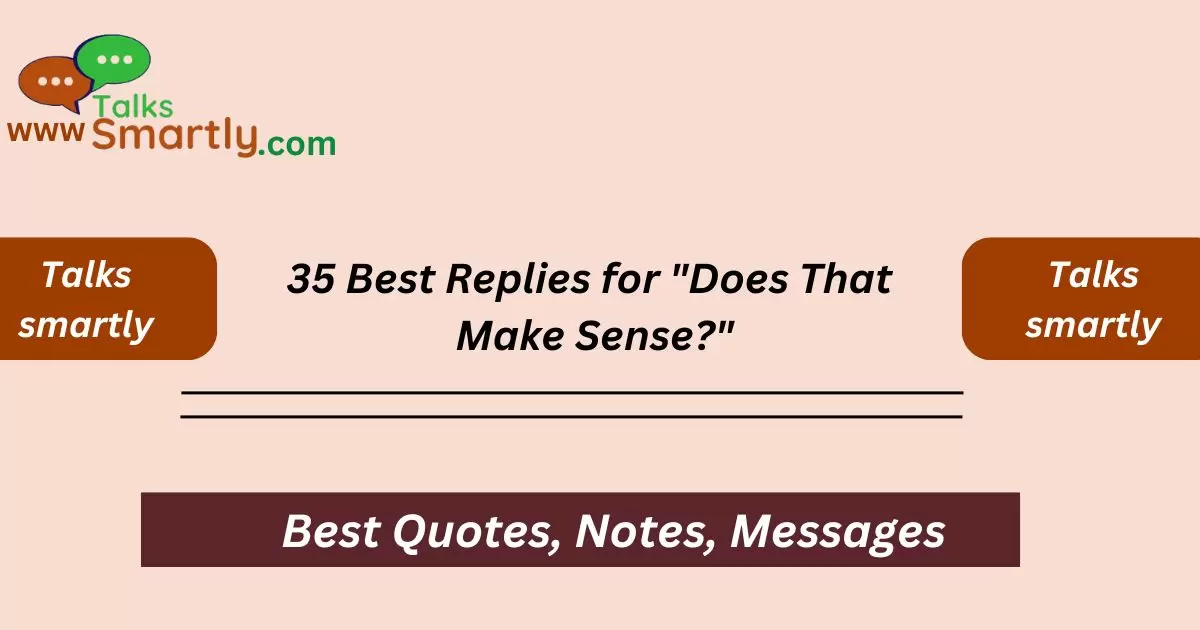“Need the perfect response when someone asks, “Does that make sense?” Here are 35 thoughtful and varied replies to keep the conversation clear and engaging.”
When someone asks, “Does that make sense?” they’re seeking confirmation that their message has been understood correctly. How you respond to this question can significantly influence the flow of the conversation and help clarify any uncertainties. Whether you’re in a meeting, a classroom, or a casual discussion, having a range of suitable replies ready can enhance communication and ensure everyone is on the same page. This variety allows you to respond appropriately based on the context and the level of understanding of the person you’re communicating with.
To improve your communication skills and keep conversations productive, consider using these 35 effective replies when someone asks, “Does that make sense?” Choose the response that best fits the situation, whether you need to provide reassurance, seek further clarification, or acknowledge understanding. By using these replies, you can navigate discussions more smoothly and ensure clear and effective communication.
In this blog post, you’ll find 35 diverse replies to the question, “Does that make sense?” Each response is designed to help you handle the situation with clarity and ease. Whether you’re confirming understanding, prompting further discussion, or just ensuring that your point is clear, these replies will offer the right words for various scenarios. Explore these options to enhance your conversational skills and improve your interactions.
35 Best Replies for “Does That Make Sense?”
- Yes, that’s clear.
- I understand what you’re saying.
- That makes perfect sense.
- Got it, thanks.
- Yes, I follow you.
- Absolutely, I see what you mean.
- It’s clear now.
- Yes, I get the idea.
- That’s quite clear.
- I comprehend it now.
- I see where you’re coming from.
- Yes, that’s very clear.
- I’m with you on that.
- That makes total sense.
- I follow your logic.
- Yes, that’s understandable.
- I grasp the concept.
- Yes, your point is clear.
- Got it, I understand.
- That’s clear to me now.
- Yes, I get your point.
- I see the point you’re making.
- Yes, that’s straightforward.
- I understand where you’re headed.
- Yes, that’s easy to follow.
- I can see what you mean.
- That’s quite understandable.
- Yes, I’m clear on that.
- I’m on the same page.
- Yes, that makes complete sense.
- I follow what you’re saying.
- Yes, that’s easy to grasp.
- I understand your explanation.
- Yes, that’s quite logical.
- I get it, thanks for clarifying.
- Detailed Responses
1. Yes, that’s clear.
A straightforward affirmation that you understand the explanation provided.
Example: “Yes, that’s clear. Your instructions make sense, and I can proceed with the task.”
2. I understand what you’re saying.
Confirms that you comprehend the message conveyed.
Example: “I understand what you’re saying about the project timeline. We should be able to meet the deadlines.”
3. That makes perfect sense.
Indicates that the explanation is completely understood and logical.
Example: “That makes perfect sense. I see how the new system will improve our workflow.”
4. Got it, thanks.
Shows that you have understood and appreciated the clarification.
Example: “Got it, thanks for explaining the details. I feel more confident about the upcoming presentation.”
5. Yes, I follow you.
Affirms that you are keeping up with the discussion or instructions.
Example: “Yes, I follow you on the budget adjustments. We’ll make the necessary changes.”
6. Absolutely, I see what you mean.
Expresses full understanding and agreement with the explanation given.
Example: “Absolutely, I see what you mean about the changes in the policy. It’s much clearer now.”
7. It’s clear now.

Indicates that the confusion has been resolved and the message is understood.
Example: “It’s clear now how the new feature works. Thanks for the demonstration.”
8. Yes, I get the idea.
Confirms that you have grasped the main concept or point being made.
Example: “Yes, I get the idea behind the marketing strategy. It’s a creative approach.”
9. That’s quite clear.
Affirms that the explanation is easy to understand.
Example: “That’s quite clear. I understand how to use the new software now.”
10. I comprehend it now.
Shows that you have gained understanding after the explanation.
Example: “I comprehend it now. The steps for the project are much more understandable.”
11. I see where you’re coming from.
Indicates that you understand the perspective or reasoning of the speaker.
Example: “I see where you’re coming from with the budget constraints. It makes sense now.”
12. Yes, that’s very clear.
Confirms that the explanation is fully understood and without ambiguity.
Example: “Yes, that’s very clear. The directions are straightforward and easy to follow.”
13. I’m with you on that.
Shows agreement and understanding with the point made.
Example: “I’m with you on that strategy for the campaign. It aligns well with our goals.”
14. That makes total sense.
Confirms that the explanation is entirely logical and understood.
Example: “That makes total sense. I can see how these changes will benefit the team.”
15. I follow your logic.
Indicates that you understand the reasoning or argument presented.
Example: “I follow your logic on the new process improvements. It’s a sound approach.”
Alternative Phrases for “Don’t Miss Me Too Much”
16. Yes, that’s understandable.
Affirms that the explanation is clear and makes sense.
Example: “Yes, that’s understandable. The plan for the event is well laid out.”
17. I grasp the concept.
Shows that you have understood the main idea or concept being discussed.
Example: “I grasp the concept of the new policy changes. It will help streamline our operations.”
18. Yes, your point is clear.
Confirms that the main point or argument is understood.
Example: “Yes, your point is clear about the project requirements. We’ll adjust accordingly.”
19. Got it, I understand.
Shows that you have comprehended the information provided.
Example: “Got it, I understand the new guidelines. We will implement them in our next meeting.”
20. That’s clear to me now.
Indicates that the message or instructions are now understood.
Example: “That’s clear to me now. The process for the application is much more straightforward.”
21. Yes, I get your point.
Confirms that you have understood the specific point being made.
Example: “Yes, I get your point about the budget limits. We’ll need to adjust our plans.”
22. I see the point you’re making.
Shows understanding of the specific argument or idea presented.
Example: “I see the point you’re making about the deadlines. We’ll need to address this issue.”
23. Yes, that’s straightforward.
Affirms that the explanation is simple and easy to understand.
Example: “Yes, that’s straightforward. The steps for the setup are clear and manageable.”
24. I understand where you’re headed.
Indicates that you follow the direction or aim of the conversation.
Example: “I understand where you’re headed with the new marketing plan. It aligns with our objectives.”
25. Yes, that’s easy to follow.
Confirms that the information is simple and comprehensible.
Example: “Yes, that’s easy to follow. The instructions for the new system are clear.”
26. I can see what you mean.
Shows that you understand the intended message or idea.
Example: “I can see what you mean about the changes in the schedule. It makes sense now.”
27. That’s quite understandable.
Affirms that the explanation is reasonable and makes sense.
Example: “That’s quite understandable. The reason for the delay is now clear.”
28. Yes, I’m clear on that.
Confirms full understanding of the topic or instructions.
Example: “Yes, I’m clear on that. The details of the project are now fully understood.”
29. I’m on the same page.
Indicates alignment and understanding with the other person.
Example: “I’m on the same page regarding the project goals. We’re ready to move forward.”
30. Yes, that makes complete sense.
Shows that the explanation is fully logical and understood.
Example: “Yes, that makes complete sense. The plan for the event is well organised.”
31. I follow what you’re saying.
Confirms that you are keeping up with the explanation or discussion.
Example: “I follow what you’re saying about the budget allocation. We’ll adjust our estimates.”
32. Yes, that’s easy to grasp.

Affirms that the explanation is clear and easy to understand.
Example: “Yes, that’s easy to grasp. The concept of the new policy is now clear.”
33. I understand your explanation.
Shows that you comprehend the details provided.
Example: “I understand your explanation of the process changes. It’s clearer now.”
34. Yes, that’s quite logical.
Confirms that the reasoning is sensible and understandable.
Example: “Yes, that’s quite logical. The approach to the problem is well thought out.”
35. I get it, thanks for clarifying.
Indicates understanding and appreciation for the additional explanation.
Example: “I get it, thanks for clarifying the steps. I’m now confident about the next phase.”
ANSWER TO KEY QUESTION
1. Why are varied replies important for “Does that make sense?”?
Using varied replies helps tailor your response to the specific situation and ensures clear communication. It allows you to confirm understanding, seek further clarification, or express agreement effectively.
2. Can these replies be used in professional settings?
Yes, these replies are suitable for both professional and casual settings. They help maintain clear communication and can be adapted based on the context of the conversation.
3. How can I choose the best reply for a given situation?
Consider the tone of the conversation, the clarity of the explanation, and the level of understanding required. Select a reply that aligns with the context and the person you are communicating with.
4. Are these replies suitable for written communication as well?
Yes, these replies can be adapted for written communication, such as emails or messages. They help ensure that your responses are clear and appropriate for various contexts.
5. Can I modify these replies to fit my style?
Absolutely! Feel free to adapt these replies to match your personal communication style and the specific nuances of your conversation.
Conclusion
Responding effectively to “Does that make sense?” is crucial for ensuring clear and productive communication. By using these 35 diverse replies, you can handle different scenarios with confidence and clarity.
Whether you’re confirming understanding, seeking further details, or expressing agreement, these replies will help you navigate conversations more smoothly. Embrace these options to enhance your communication skills and foster better interactions in both personal and professional settings.

Hi, I’m Lauren Reynolds, owner of Talks Smartly.
We specialize in wishes, thank you messages, and thoughtful responses for all occasions.
Whether it’s a birthday wish or a heartfelt thank you, we’re here to make your messages shine.
Join us at Talks Smartly and let your words leave a lasting impression.”











